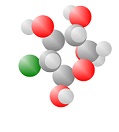Positron emission tomography (PET) is a nuclear medicine imaging technique
that produces a three-dimensional image or picture of functional processes in the body. The system detects
pairs of gamma rays emitted indirectly by a positron-emitting radionuclide (tracer), which is introduced
into the body on a biologically active molecule.
To conduct the scan, a short-lived radioactive tracer isotope is injected into the living subject
(usually into blood circulation). The tracer is chemically incorporated into a biologically active molecule.
There is a waiting period while the active molecule becomes concentrated in tissues of interest; then the subject
is placed in the imaging scanner.
The molecule most commonly used for this purpose is fluorodeoxyglucose (FDG),
a sugar, for which the waiting period is typically an hour. During the scan a record of tissue concentration is
made as the tracer decays.
|

|

|
Within 110 minutes, there is a 50% chance that one of the fluorine protons will decay into a neutron and positron.
As the radioisotope undergoes positron emission decay (also known as positive beta decay),
it emits a positron, an antiparticle of the electron with opposite charge.
The fluorine nucleon becomes a oxygen nucleon with extra neutrons. More.. |
The emitted positron travels in tissue for a short distance (typically less than 1 mm,
but dependent on the isotope), during which time it loses kinetic energy, until it decelerates
to a point where it can interact with an electron.
The positron (sometimes called an anti-electron or a left-handed electron) cannot have its spinning components
lined up with an electron no matter their orientation.
The encounter annihilates both electron
and positron, producing a pair of annihilation (gamma) photons moving in approximately
opposite directions.
More..
The most significant fraction of electron-positron decays (electron/positron mass = 511 keV) result in two 511 keV gamma
photons being emitted at almost 180 degrees to each other.
These are detected when they reach a scintillator in the scanning device, creating a burst of
light which is detected by photomultiplier tubes or silicon avalanche photodiodes (Si APD).
Inorganic crystals are best suited as a scintillator for the detection of gamma rays
through the photoelectric effect.
More..



